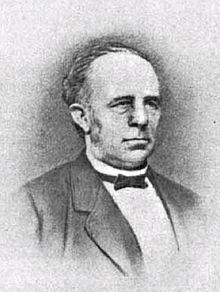Franz Varrentrapp
Franz Varrentrapp (born August 29, 1815 in Frankfurt am Main ; † March 4, 1877 in Braunschweig ) was a German chemist and entrepreneur.
life and work
The son of the Frankfurt doctor Johann Conrad Varrentrapp (1779-1860) and Maria Christina, née Hofmann (1785-1859) completed an apprenticeship as a pharmacist in Lausanne from 1832 to 1835 . He then worked in pharmacies in Rastatt and Dresden before studying chemistry with Heinrich Rose and Eilhard Mitscherlich in Berlin from 1837 to 1839 . From 1839 to 1840 he continued his studies at the University of Giessen , where he did his doctorate under Justus von Liebig . In Giessen he and Heinrich Will developed the Will-Varrentrapp method for determining nitrogen . Research trips to England and Scotland followed in the autumn of 1840.
Activity in Braunschweig
Through the mediation of Liebig, who was friends with the Braunschweig publisher Eduard Vieweg , Varrentrapp became secretary of the trade association in Braunschweig in November 1841. There he supported industrialists and tradespeople as a business advisor. He suggested the preservation of asparagus in metal cans and thus founded the later flourishing canning industry in Braunschweig . In 1843 he married Elisabeth Kellner († 1850) in Frankfurt am Main. The following year, due to a vacancy, he became a teacher of physics and chemistry at the Anatomical-Surgical Institute . In 1846 he was appointed professor and in 1850 mining commissioner and coin validator . He carried out both tasks until the cessation of minting in 1860 and until the dissolution of the Anatomical Institute in 1869. In 1852 he married Dorette Krüger in Braunschweig for the second time. In 1868 he turned down a call to the newly founded Aachen Polytechnic. Varrentrapp, on the other hand, accepted the offer of his friend Heinrich Vieweg to become a partner in the publishers "Friedrich Vieweg und Sohn" and "Gebrüder Vieweg". He died in Braunschweig in 1877 after a long illness.
Others
The Varrentrappstrasse in Braunschweig and Frankfurt am Main are named after him.
In Frankfurt, at the confluence with Theodor-Heuss-Allee, is the seat of the German Bunsen Society for Physical Chemistry .
family
Varrentrapp married Elisabeth Kellner (1819–1850) on October 9, 1843 in Frankfurt. The couple had several children:
- Conrad (1844–1911), Professor of History in Bonn ⚭ Caroline Beneke (* 1854)
- August Wilhelm (* 1853), Landbaurat in Königsberg ⚭ 1880 Minka Heinz (* 1856)
After the death of his first wife, he married Dorothea Krüger (1832–1899) on July 15, 1852 in Braunschweig. The couple had several children:
- Albert Johannes (* 1856), businessman ⚭ 1888 Katharina Helene Forsthövel (* 1859)
- Georg Eduard (1857-1858)
- Son (1860-1860)
- Friedrich Gustav (* 1863), captain ⚭ 1892 Maria Christiane Elisabeth Noll (* 1868)
- Son (1864-1864)
- Eduard (1869–1928), German Rear Admiral ⚭ 1904 Anna Mathilde Weydt (* 1879)
- Elisabeth (1870–1937)
literature
- Werner Arnswaldt: From the history of the Varrentrapp family. Plate VI. Descendants of Franz Varrentrapp
- Horst-Rüdiger Jarck : Varrentrapp, Franz, Prof. Dr. In: Horst-Rüdiger Jarck , Günter Scheel (ed.): Braunschweigisches Biographisches Lexikon - 19th and 20th centuries . Hahnsche Buchhandlung, Hannover 1996, ISBN 3-7752-5838-8 , p. 623 .
- Norman-Mathias Pingel: Varrentrapp, Franz. In: Manfred Garzmann , Wolf-Dieter Schuegraf (ed.): Braunschweiger Stadtlexikon . Supplementary volume. Joh. Heinr. Meyer Verlag, Braunschweig 1996, ISBN 3-926701-30-7 , p. 133 .
- Heiko Stoff: Varrentrapp, Franz. In: New German Biography (NDB). Volume 26, Duncker & Humblot, Berlin 2016, ISBN 978-3-428-11207-5 , p. 720 ( digitized version ).
Web links
- Article by / about Franz Varrentrapp in the Polytechnisches Journal
- Varrentrapp, Franz. Hessian biography. (As of August 2, 2020). In: Landesgeschichtliches Informationssystem Hessen (LAGIS).
Individual evidence
- ↑ Parents see Varrentrapp, Franz. Hessische Biographie. In: Landesgeschichtliches Informationssystem Hessen (LAGIS).
- ^ Karl-Rudolf Döhnel: The Anatomical-Surgical Institute in Braunschweig 1750–1869. In: Braunschweiger Werkstücke , publications from the archive, library and museum of the city, Volume 19, Waisenhaus-Buchdruckerei und Verlag, Braunschweig 1957.
- ^ Franz Varrentrapp - Chemist in the publishing industry on pharmische-zeitung.de (detailed biography), accessed on February 2, 2013.
| personal data | |
|---|---|
| SURNAME | Varrentrapp, Franz |
| BRIEF DESCRIPTION | German chemist |
| DATE OF BIRTH | August 29, 1815 |
| PLACE OF BIRTH | Frankfurt am Main |
| DATE OF DEATH | March 4, 1877 |
| Place of death | Braunschweig |

